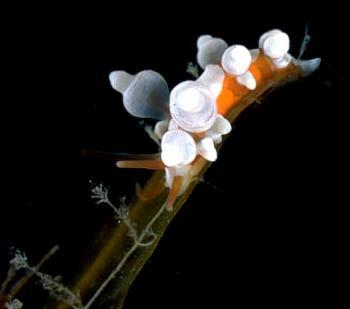
Eubranchus inabai
Baba, 1964
Order: NUDIBRANCHIA
Suborder: AEOLIDINA
Family: Eubranchidae
DISTRIBUTION
Japan to eastern Australia
PHOTO
Entrance to Wallis Lake, Tuncurry, Tuncurry, New South Wales, Australia, 1 Feb 1988. 12mm long alive. AM C155113. Photos: Bill Rudman
These species has a very characteristic colour pattern, orange body with a series of large white patches on the dorsum. It has prviously been recorded only from Japan but Bernard Picton's records here from Hong Kong, and my record from eastern Australia suggest it either has a much wider natural distribution or is being spread perhaps by shipping.
Reference:
• Baba, K. (1964). Description if Eubranchus inabai n. sp. from Mukaishima, Japan (Nudibranchia-Eolidoidea). Publications of the Seto Marine Biological Laboratory, 12(4): 13-15.
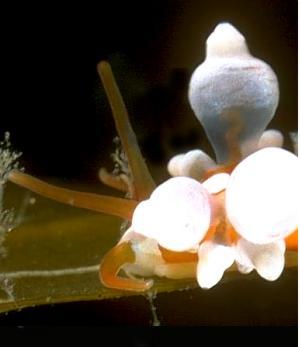
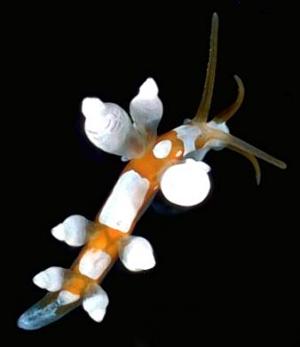
Rudman, W.B., 2001 (March 6) Eubranchus inabai Baba, 1964. [In] Sea Slug Forum. Australian Museum, Sydney. Available from http://www.seaslugforum.net/find/eubrinab
Related messages
Eubranchus inabai from Japan.
September 11, 2002
From: Jun Imamoto
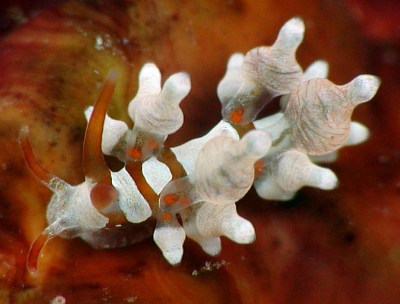
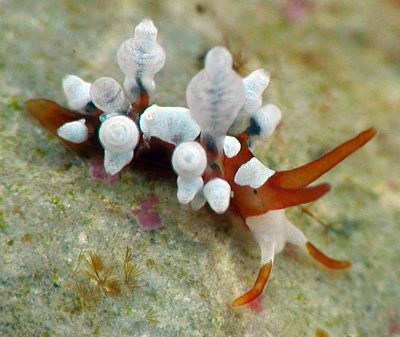
Dear Bill.
As for this sea slug, it doesn't seem to be reported to the Forum from Japan, so here is a Japanese individual. They were found on a rock wall in shallow water. There were many sponges and seaweed. I am happy if these reports are useful for your research.
Date: 10 July 2002
Location: Wakasa Bay, Echizen-coast, Japan
Size: About 5-6mm
Depth: 4m
Temperature: 23C
Best Regards,
Jun Imamoto
http://umiushi.zive.net/
imamoto@wips.co.jp
Imamoto, J., 2002 (Sep 11) Eubranchus inabai from Japan.. [Message in] Sea Slug Forum. Australian Museum, Sydney. Available from http://www.seaslugforum.net/find/7783Thanks Jun,
It's nice to get some photos from Japan, as that is where it was originally described from.
Best wishes,
Bill Rudman
Re: Eubranchus inabai from Australia
March 13, 2001
From: Richard.Willan
Dear Bill,
I consider Eubranchus inabai to have been introduced into eastern Australia by shipping. It would be worth people keeping an eye out for it to decide whether it has established in this country or not. Following my review of all marine molluscs potentially introduced into Australia (I presented an address on this topic at the mollusc conference in Sydney last year), I believe the following 8 species of opisthobranchs are non-indigenous: Aplysiopsis formosa, Kaloplocamus ramosus, Polycera capensis, Polycera hedgpethi, Janolus hyalinus, Eubranchus inabai, Tenellia adspersa, Godiva quadricolor.
Reference
Willan, R.C. (2000) Marine molluscan introductions into/within Australia: can we do any more than monitor the arrival and spread of non-indigenous species? Molluscs 2000 Abstracts: page 87.
Best wishes,
Richard
Richard.Willan@nt.gov.au
Willan, R., 2001 (Mar 13) Re: Eubranchus inabai from Australia. [Message in] Sea Slug Forum. Australian Museum, Sydney. Available from http://www.seaslugforum.net/find/3956Thanks Richard,
Bill Rudman
Re: Eubranchus inabai from eastern Australia
March 9, 2001
From: Bernard Picton
Hi Bill,
Concerning your comment on their apparently unusual distribution, I noticed in Hong Kong that Sargassum had a load of epiphytic hydroids and Bryozoans on it. Now Sargassum has spread to the UK and France with Oyster cultivation, but seems to have arrived without its associated species. I wonder if this is another possibility for these small animals getting around the planet?
Bernard
bernard.picton.um@nics.gov.uk
Picton, B., 2001 (Mar 9) Re: Eubranchus inabai from eastern Australia. [Message in] Sea Slug Forum. Australian Museum, Sydney. Available from http://www.seaslugforum.net/find/3951Dear Bernard,
I don't see why not. I suspect it's why Vayssierea felis, despite its direct development, has such a wide geographic distribution. It is often found feeding on the tube worm Spirorbis attachd to laminarian algae.
Best wishes,
Bill Rudman
Eubranchus inabai from Hong Kong
March 8, 2001
From: Bernard Picton
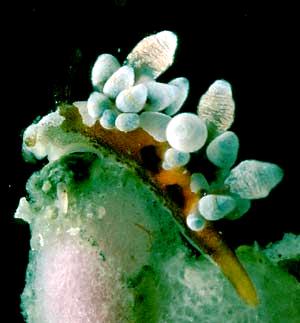
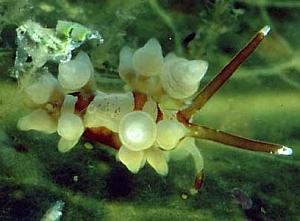
Dear Bill,
Here are photos of a Eubranchus species from Hong Kong which I identified as Eubranchus inabai Baba, 1964. They were found feeding on small hydroids on Sargassum in shallow water.
UPPER PHOTO: NW Kong Chau, Mirs Bay - 11 April 1983 - 5mm long [BEPHK91]
LOWER PHOTO: West Pak Sha Chau, Mirs Bay - 14 April 1983 - 5m - 4mm long [BEPHK190]
Bernard
bernard.picton.um@nics.gov.uk
Picton, B., 2001 (Mar 8) Eubranchus inabai from Hong Kong. [Message in] Sea Slug Forum. Australian Museum, Sydney. Available from http://www.seaslugforum.net/find/3934Thanks Bernard,
This gives me a reason to post some photos of this species from eastern Australia. I don't know if the occurrence in Australia is part of its natural distribution or the result of shipping, although the region where they were found, is a small fishing village rather than an international sea port.
Cheers,
Bill Rudman
Eubranchus inabai from eastern Australia
March 8, 2001
From: Bill Rudman

To accompany Bernard Picton's message with photos of Eubranchus inabai from Hong Kong, here is a photo of an animal from New South Wales in eastern Australia. I have posted the details, and more photos at the top of the page. I don't know if its occurrence in eastern Australia is part of its natural distribution or the result of shipping, although the region where they were found is a small fishing village, rather than an international sea port.
Best wishes,
Bill Rudman
